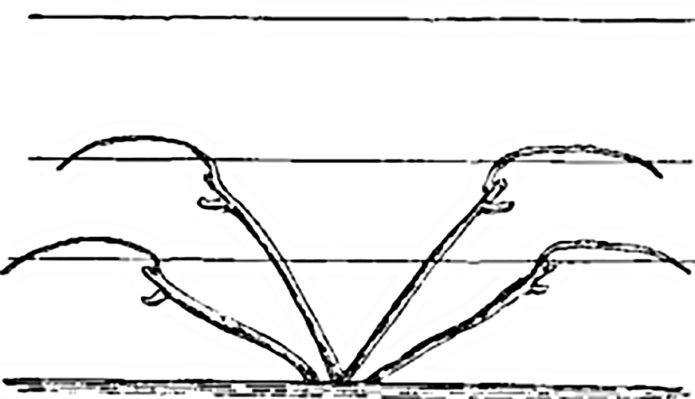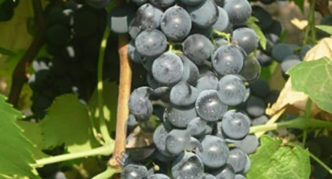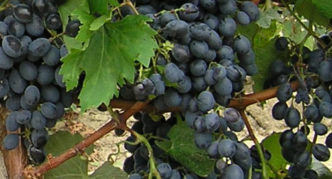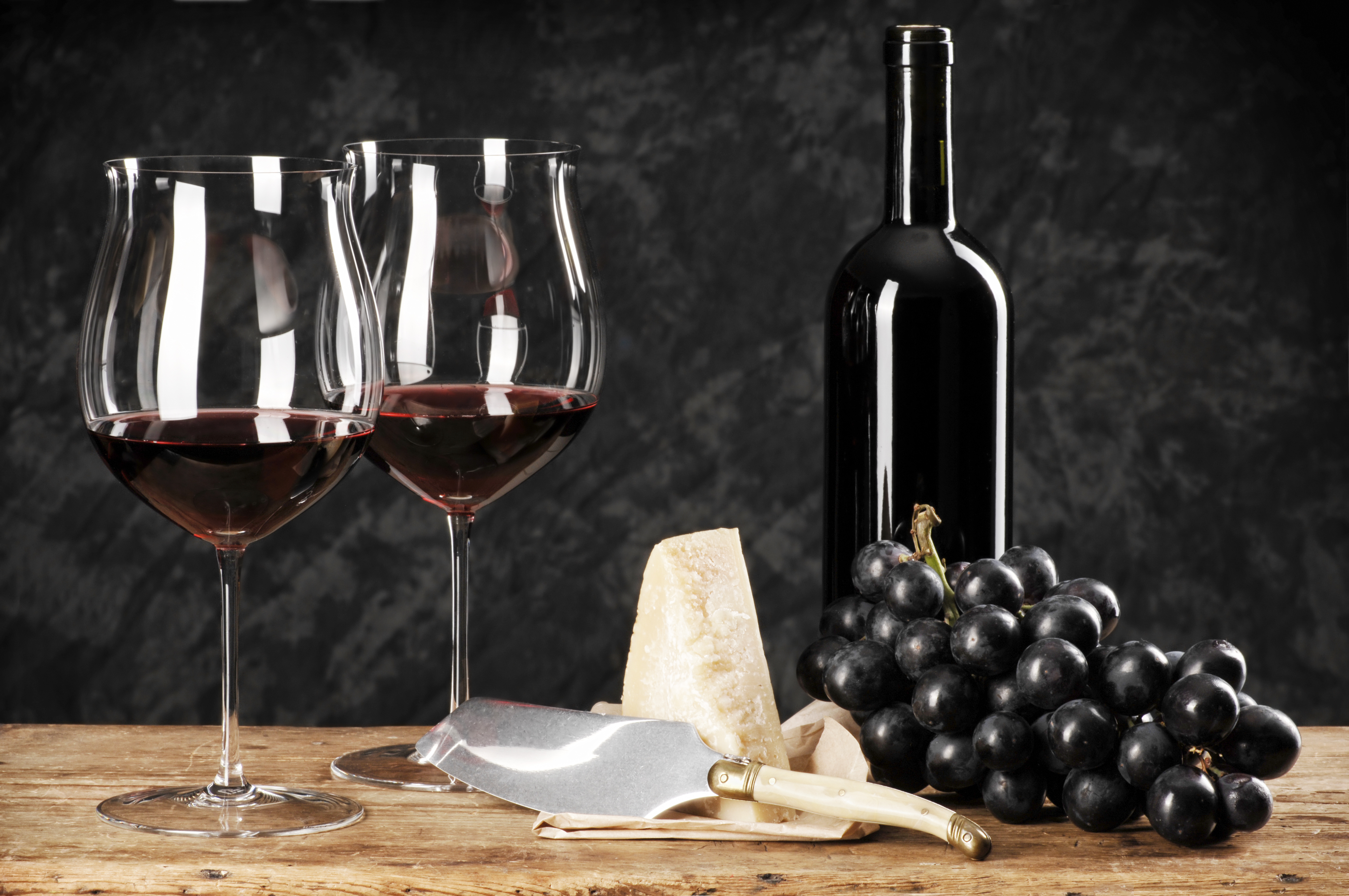For lovers of home winemaking and producers of a sunny drink, technical grape varieties are important, which sometimes do not shine with the beauty of the bunches, do not amaze with the size of the berries, but when ripe they have a harmonious taste with the necessary ratio of sugar and acids, and give a lot of juice. One of the famous technical grape varieties is Livadia black, which will be discussed.
Content
Whose brainchild is this
On the Internet, on many sites devoted to grapes, viticulture and winemaking, the story about Livadia black begins with the fact that this variety was created at the Magarach Institute in Yalta and the famous scientist-breeder Pavel Golodryga led the development of new grapes.

The Livadiysky black variety was bred at the Yalta institute "Magarach", the famous scientist-breeder Pavel Golodryga supervised the work on the creation of a new grape
However, the FSBI "State Sort Commission", which gives official information about the varieties of plants registered in the State Register, in the description of the grape variety Livadiyskiy black, calls the Limited Liability Company the Scientific and Innovation Company "AMPELOS" as the originator.
Oddly enough, but both information is correct. AMPELOS was created to continue the study of the richest heritage of the outstanding breeder Pavel Golodryga. In 2013, the firm celebrated its 20th anniversary, and here is what they themselves report about their work during this period:
“We approached this date with ten P.Ya. Golodrygi varieties: Chocolate, Livadia Muscat, Amateur - varieties for fresh consumption, Gurzufsky pink, Golodrigi Muscat - universal, Golodrygi Rubin, Black Livadia, Bukovinka, Risus, Oleg - wine. "
Since August 2008, Livadiysky Black has been undergoing a variety trial at the State Variety Commission, and in 2017 it was officially entered into the register of grape varieties recommended for cultivation in the North Caucasus region.
Getting to know better
The parental pair of Livadia Black was Magarach 124–66–26 and the Armenian table grape Megru Vagaas. In the description of the variety given by the Federal State Budgetary Institution "State Sort Commission", it is said that these are grapes with an average ripening period. On the Internet, you can find a clarification that this period is 130-140 days from the opening of the first buds.
Bushes of medium vigor of this technical grape with well-ripening shoots give relatively small clusters weighing about 0.2 kg, sometimes slightly more - up to 250 g. They are cylindrical with wings and not very dense.
Round black berries, weighing 1.5–2 grams each, have a thin firm skin, which is intensively covered with purine bloom. The grapes have a nutmeg aroma with tones, as stated in the official description, of the Kazanlak rose. Kazanlak is a Bulgarian city located in the famous Rose Valley - fields of Damascus rose oil at the foot of the Stara Planina Mountains.
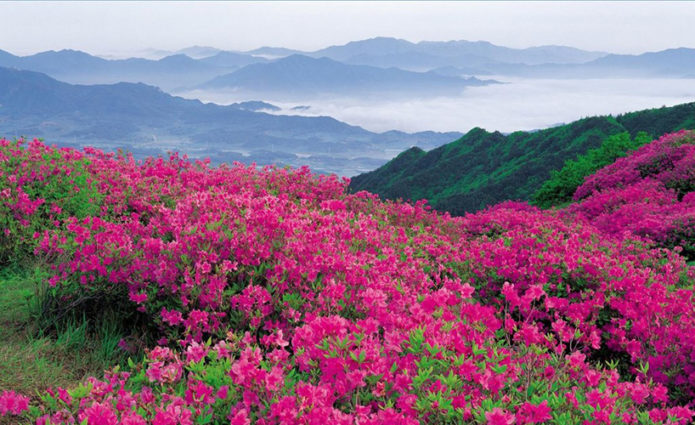
Kazanlak is a Bulgarian city located in the famous Rose Valley - fields of Damascus rose oil at the foot of the Stara Planina mountains
By the time of harvest, Livadia black grapes accumulate almost 25% of sugar, and acids - 7.8 grams per liter of juice, of which the berries contain 80–90%. Dry wine made from these berries was rated 7 points by the tasters. Dessert wine with flavors of nutmeg, prunes, chocolate received 8 points out of eight possible.
An average of 13.7 tons of berries are harvested from one hectare of vineyard planted with vines of Livadia black. Grapes are moderately susceptible to infection with gray mold, downy mildew and powdery mildew. It can withstand winter frosts down to -25 ºС.
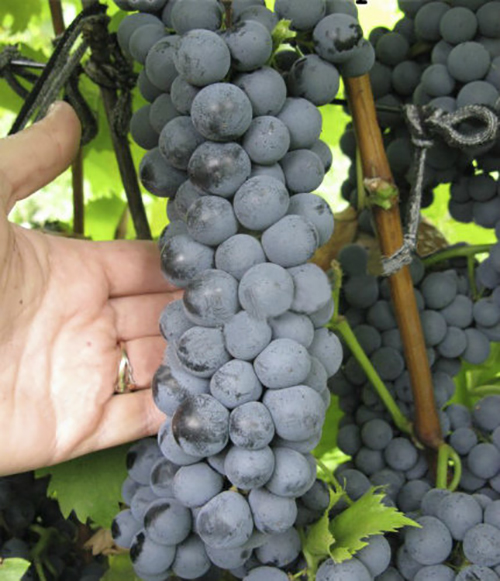
By the time of harvest, Livadia black grapes accumulate almost 25% of sugar, and acids - 7.8 grams per liter of juice, which contains 80-90% in berries
Caring for Livadia Black
Planting Livadia black seedlings and caring for the vines of this variety are absolutely similar to all operations carried out on other varieties.
For good ripening of this technical grape, a well-lit and warmed up by the sun, preferably a sheltered place with deep groundwater, is chosen.
The planting hole is prepared in advance so that the soil with which it is filled has time to compact. On heavy soils, the bottom of the pit is covered with a drainage layer 10–15 cm thick, consisting of fine gravel, crushed stone, broken bricks or other similar materials. In the center of the pit, a support stake is installed for tying a young plant, and on the side, a pipe ø10 cm can be placed for irrigation under the plant roots. Above the drainage there is a layer of soil of the same thickness, mixed with rotted mullein or compost in a 1: 1 ratio. The pit is filled to the top with fertile soil.
A support is required for the vine - a trellis or a gazebo. It is also advisable to prepare it in advance. Livadia black is also planted near the fence. If it is made of a chain-link mesh, a horizontal cable or thick wire is pulled on top so that the fence does not deform under the weight of the vine.
Experience in growing technical grapes - video
The formation of a bush of grapes begins in the second year of growth of a seedling on the site. For Livadia black grapes, fan-shaped bush is often used.
The verbal description of the process of vine formation by novice winegrowers is perceived with difficulty, although it is not particularly difficult. You can clearly see the initial stage of fan formation in the following video.
The beginning of the formation of grapes in the form of a fan - video
Care for the Livadia black variety is standard, as for all grape varieties.
- Three obligatory watering to the root depth (at least 5 buckets per 1 m2):
- before budding in early spring;
- before flowering grapes;
- during the ripening period of the berries, but no later than two weeks before cutting the bunches.
Additional watering is carried out depending on weather conditions. The soil should not dry out, but excess moisture is not needed so that the roots can breathe freely.
- Two mandatory preventive treatments with fungicides (Ridomil Gold, Shavit or the like) before and after flowering of the vine. In case of a fungal disease, additional processing of the grapes is carried out.
- The soil under the grape bushes is kept constantly loose. It is especially important to loosen it after watering and rains, so that the upper compacted layer does not interfere with the access of air to the roots. An alternative can be mulching with organic substances (humus, mown grass, peat, etc.) with a layer not thinner than 5 cm.
- Pruning grapes:
- Spring sanitary, when frozen, broken, damaged shoots are removed.
- Summer - "green operations": breaking off infertile shoots, stepchildren, pinching and chasing shoots, thinning leaves (removing from 5 to 10 pieces at the base of the shoot) to improve nutrition and ripening of bunches.
- Autumn - the formation of a bush and its preparation for winter.
- Constant monitoring of the condition of the plant for timely detection of pests or diseases.
Is Livadia black really good
In order to clearly understand the advantages and disadvantages of the Livadiysky black variety, it is reasonable to compare it with other technical grape varieties ripening at the same time and recommended for cultivation in the same region of the North Caucasus. Let's turn to the State Register. For example, let us take into consideration the variety of Crimean and Memory of Golodryga.
Comparison varieties: table
| Livadia black | Crimean | In memory of Golodryga | |
| Bush size | middle | tall | middle |
| Harvest ripening (days) | 130–140 | 133–138 | 150 |
| Average bunch weight (g) | 195,8 | 180 | 208 |
| % sugar in ripe berries | 24,8 | 27 | 25,7 |
| Acid (g / dm3) | 7,8 | 8,7 | 8,6 |
| Productivity (average t / ha) | 13,7 | 12,5 | 12,6 |
| Evaluation of wine on a tasting scale (points) | 7 | 7,8 | 7,9 |
| Low temperature resistance (° C) | -25 | -24 | -23 |
| Disease and pest resistance | weakly affected | weakly affected | weakly affected |
As can be seen from the table, the parameters of the compared varieties are very close. The variety in Memory of Golodryga is somewhat inferior in terms of ripening, but has the highest assessment of the taste of wine. If more sugar accumulates in the berries of a Crimean resident, then there is much more acid in his berries than in Livadia. The resistance of these grapes to frost, diseases, pests is practically the same, and the yield of Livadiysk is slightly higher than that of its competitors. That is, each of the selected varieties has its own advantages, but at the same time it is inferior in other parameters.
Compared varieties in the photo
- Crimean grapes
- Black Livadia Grape
- Golodryga Memory Grapes
Livadia black in Ukraine
Reviews of winegrowers from different regions about the Livadia black variety
As for Livadia black, even this completely dry summer my seedlings picked up mildew. For my modest demands for the quality of wine, with relatively high requirements for disease resistance and the presence of only 2 seats at the fence, this is unacceptable. The person from whom I took seedlings lost this variety due to freezing. So the decision appeared to replace it with something closer in resistance to Platovsky (the ideal of grapes at the fence) and Crystal.
Livadia black bears fruit in my 3rd year. First, a control bunch on a two-year-old, then a small harvest on a three-year-old house, and now something that looks like a harvest (though the hail has cut back) this year. Honestly, I did not make wine from this variety. Despite the fact that it is a wine variety, Livadian black berries are large enough (among wine ones) and have a very pleasant, delicate nutmeg taste. Therefore, they were instantly eaten by my household. For some reason it seems to me that the wine should be good. In addition, there is no reason not to trust various sources indicating that wine from Livadia black is not just good, but excellent taste !! I'm going to make some wine this year. But most likely I will mix several varieties - Fortune, Mendeleum, Early Violet and Livadia Black.
Greetings, Sergey Dnepr
If you want to have the best result according to Livadiyskiy in specific conditions and if you use the variety as a table variety, leave one bunch per shoot. Leave a few sterile shoots and then the result will be completely different, in general, study the variety in your own conditions. And I would also like to draw your attention to the fact that the technological maturity of wine varieties occurs at a sugar content of 18%, when the harvest is suitable for producing dry wine. By this date, the ripening period is determined. If the task is to get dessert wine and the variety has the genetic potential to accumulate higher sugar, then it is natural that, if conditions permit, the harvest can be harvested in September and October.The highest sugar content in Livadiyskiy black in Yalta was 26% at the end of September at the state farm collection in LIVADIA.
Livadia black has become one of the favorite varieties of winegrowers due to its frost resistance, which allows it to be grown in the middle lane, the stability of high yields, good resistance of grapes to powdery mildew and gray rot, crop suitability for fresh consumption and for processing at home and in production.
